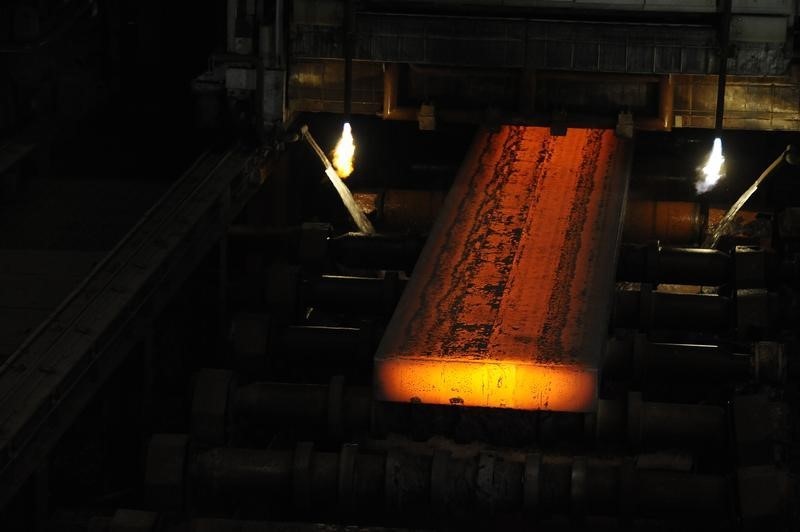(Repeats with no changes to text)
By Clyde Russell
LAUNCESTON, Australia, Oct 1 (Reuters) - - It's a brave analyst these days who would call a bottom in the iron ore price, which makes the call for better times by 2017 from the normally cautious Australian government forecaster all the more interesting.
While any forecast for iron ore prices to rise is worth more than just a glance, there are a few things to note about the Australian Department of Industry's Resource and Energy Quarterly, published on Wednesday.
The most important is that the government forecaster isn't calling for a dramatic rebound in iron ore, rather for modest gains.
The second is that the recovery isn't expected until 2017, with next year expected to show further losses for the steel-making ingredient.
The report projected that iron ore will rise to average $60.40 a tonne in nominal terms in 2017, up from $51.20 in 2016 and $52.90 this year.
By way of comparison, the department's June quarter report forecast iron ore would average $54.40 a tonne in 2015 and $52.10 in 2016, but didn't provide forecasts for further out years.
What has effectively happened is that the department has become slightly more bearish on the view for this year and next, before expecting a modest recovery from 2017 onwards.
Just how modest is the recovery expected to be?
The spot price of iron ore in AsiaI was $54.40 a tonne on Wednesday, down about 24 percent from the end of last year, but up from the $44.10 reached on July 8, which was the lowest since spot assessments started in November 2008.
The department is therefore expecting iron ore to be 5.9-percent weaker in 2016 than it is currently, before gaining to be 11 percent higher in 2017 than the present spot price.
While the improvement by 2017 is not that dramatic in percentage terms, it still makes the department a bit of an outlier among iron ore forecasters.
Major Australian bank ANZ expects iron ore to average just $55 a tonne in 2016 and 2017, while Morgan Stanley (NYSE:MS) is only slightly more optimistic at $58 for both years.
And even these institutions are more bullish than the wider market, with a Reuters poll of 17 analysts published on Sept. 23 showing iron ore expected to average just $50 a tonne in 2016 and 2017.
The question then becomes why is the Australian government expecting improvement when others are more sceptical?
The bearishness on prices for this year and next is driven by increasing supply, mainly from top exporter Australia and number two Brazil.
Australia's exports are expected to rise from 717 million tonnes in 2014 to 762 million tonnes this year, 824 million in 2016 and 886 million by 2017, the department said.
Those from Brazil will increase from 363 million tonnes last year to 390 million in 2015, 412 million in 2016 and 435 million in 2017.
The rising exports from the top two producers will be enough to keep prices weak for this year and next, but climbing global steel output and the closure of high-cost iron ore mines will allow prices to rise by 2017.
CHINA IRON ORE MINERS BATTLING
The department said that domestic Chinese iron ore producers are struggling, with output falling 9 percent year-on-year in the first seven months of 2015 and the number of mines reporting losses rising to 29 percent from 22 percent.
However, the department also acknowledged that one of the key risks in its forecast is the viability of China's domestic iron ore industry.
"If the government implements market based reforms, China's domestic production of iron ore is likely to fall, which will increase import requirements and provide support to the seaborne price of iron ore over the medium term," the report said.
While this certainly is logical, it's by no means assured with Chinese miners showing a willingness to keep producing at a loss for extended periods, given that keeping jobs is often viewed as more important than profits.
The department also expects China's steel output to remain fairly constant in the coming years at around 802 million tonnes a year, down slightly from the 823 million reached in 2014.
This is also a forecast that runs the risk of being too optimistic, as it assumes that China can successfully export its surplus production, which is likely to be at least 50 million tonnes a year.
Domestic steel consumption is likely to be slightly less than 750 million tonnes a year, and even that assumes a relatively strong economic growth profile with all the promised infrastructure spending being realised.
Such is the nature of forecasting that assumptions have to be made, and the ones done by the Australian government aren't unreasonable.
However, while not assuming a best-case scenario, they are assuming ongoing economic growth of around 6.5 percent in China's the buyer of two-thirds of seaborne iron ore, and that this growth will include a strong infrastructure component.
While iron ore producers will no doubt be pleased to see even a cautiously bullish forecast, the risks to the department's views still seems to be biased to the downside.
(Editing by Joseph Radford)
